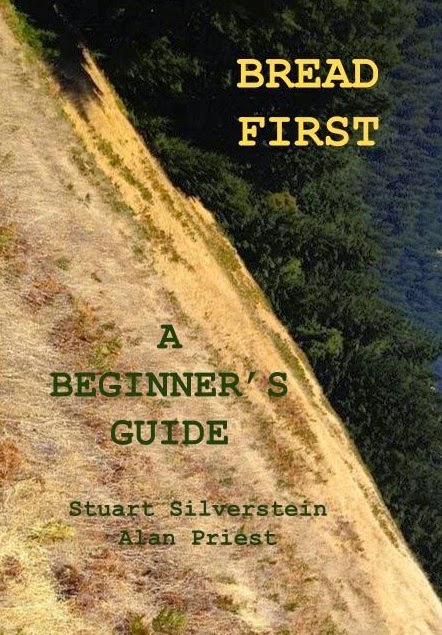I’m not really sure where bialys originated, but my guess would be Poland because that country has a large city called Bialystok. Many Jews emigrated from Poland to America, and some of these émigrés had superb baking skills.
On New York City’s Lower East Side, I know of a bakery that specializes in the production of Bialys-chewy rolls with flattened or concave centers into which chopped onion and poppy seeds have been mushed. To my knowledge and taste, this bakery in New York is the only place where authentic bialys are made. I’ve eaten bialys from Boston and South Florida, but they were really dismal samples. Unless you go to New York City for a bialy, the only other place you can find a good one is in your kitchen after you learn how to make them.
The essence of a good bialy is its chewiness, and one way to produce chewiness is through the use of high gluten flour. In my book Bread In Time, I outlined that technique. Another way to get a chewy texture is with sourdough starter, and I’m pretty sure the traditional bialy was made that way and not with high gluten flour. Sourdough can be created by the baker, while high gluten flour is a specialty flour that most likely wasn’t even available when bialys were developed.
You may very well want to double the ingredients in this recipe, which of course, will double the yield. (Do not, however, double the amount of starter you use-1 cup is enough.) I make this suggestion because bialys are a special treat, and they will be devoured quickly.
INGREDIENTS
1 cup warm water (about 85)
1 cup sourdough starter
1 teaspoon salt (what you normally use)
1/2 teaspoon coarse or kosher salt
3 1/2 cups wheat flour (I don’t recommend whole wheat because it will make the bialys too heavy, although white wheat flour is definitely an option. Try wheat flour with the restored germ, white or a combination.
1 tablespoon poppy seeds (seeds, spices, and herbs are almost always fresher and cheaper to buy in natural food stores than in supermarkets)
1/2 cup chopped onions
bran for dusting
YIELD: 14 (3 1/2” diameter) bialys
PROCEDURE
Stir starter into the warm water. You can use the starter straight from the fridge. (replenish your starter.)
Stir in 1 teaspoon of ordinary salt, not the coarse kind. Incorporate about 3 cups of the flour by stirring vigorously. When the mixture comes away from the sides of the bowl, turn it out on your work surface, heavily dusted with about 1/2 cup of flour, and knead for about 5 minutes until the dough becomes loamy and satiny.
Place the dough in a clean, dry, unoiled bowl, large enough to allow the dough to double in bulk. Cover the bowl and set in a warm place, about 80 degrees, for approximately 4 hours. If you starter is robust, with lots of vim, and vigor, and if the temperature is about right, it should double in the allotted time. However there are so many interesting variables in bread baking that it might take 6 hours or just 3 hours for the dough to double in bulk.
When the dough is ready, turn it out on a floured work surface. Tumble the dough around for a couple of moments in the flour, let it rest briefly, and then roll it out with a rolling pin to a uniform thickness of about 1/2”.
Cut out the bialys. I use an empty 3 1/2” diameter juice can to punch out the bialys by bearing down firmly. Sprinkle bran on 2 standard-sized cookie sheets (insulated sheets are okay, but not necessary here), and place the bialys on the sheets.
Cover with cloths and set in a warm place about 80 degrees F. to rest and rise for 30 minutes. While you’re waiting, chop the onions and get out the coarse salt and the poppy seeds.
Preheat the oven to 400. In the top center of each bialy deposit a pinch of chopped onions, some poppy seeds and a tiny bit of coarse salt. With your fist, must these ingredients into each bialy. Don’t be afraid to mush down hard.
Mist your bialys with water from a clean plant sprayer. (You should not be using a sprayer that ever housed a chemical. In fact, the sprayer should be one used only for bread baking.) Slide the cookie sheets onto a rack in the middle of the oven and bake for 20 minutes. During the first 10 minutes of the bake, mist the bialys 2 or 3 more times with the sprayer. Just reach into the oven, mist them, and quickly close the door.
Ideally the centers should still be flattened when the bialys emerge from the oven, but this will not always be the case. Don’t worry, they’ll still be delicious even if they rise like rolls.
The bialys are done when they turn golden in color. If you have baked the bialys for the allotted time and they have not turned golden or amber in color, try this trick, but be careful: Slip the bialys under the broiler for just a few moments. If they are not monitored almost continuously, you’ll burn them hopelessly. And I don’t want to have to say I told you so.
Update: Now I easily bake bialys in one of my three wood-fired outdoor ovens.






No comments:
Post a Comment